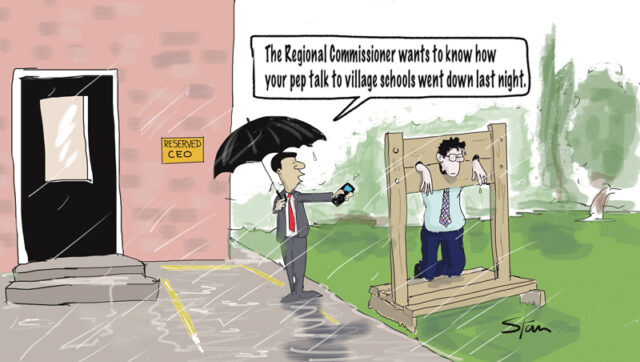In a week of big news – threatened strikes, parent boycotts, backbenchers shouting about academies – there has been one quiet sigh of relief. And one awkward question.
Buried in the middle of her speech at the weekend’s union conference, Nicky Morgan promised that “no good small school will close” due to “structural changes” – and by structural change I presume she means her plan to turn every school into an academy and not that she’s going to start knocking down their interior walls.
For local councillors in areas with small schools, this is a relief. More than 2,000 schools in England have fewer than 100 pupils. The fear has been that if they are forced to join an academy trust, a CEO without an understanding of their value may decide they are no longer viable – and so close them.
“That’s the fear, that’s the trepidation,” said Neil Short, chair of the National Association for Small Schools, when we spoke this week. “I spoke to heads in North Yorkshire last week who are afraid of the unknown. At the moment, we are still trying to piece together the evidence.”
He takes comfort in the education secretary’s words but he notes the “good” in her statement. “I take comfort, provided her definition of good is the same as mine. The Ofsted evidence is that most small rural schools are good, something like 95 per cent of the total,” he says.
In the past Morgan has also thrown the word “sustainable” into the mix as a necessary criterion for small schools to stay open.
Schools with fewer pupils are almost always more expensive. They are necessary though. In parts of the Yorkshire dales snow falls several times a year, and makes roads to more distant schools impassable. This is why, so far, top-up cash has been available through “sparsity” grants and it is believed this factor will be built into the planned school funding formula.
The awkward question is one that several heads have asked, not just those in small schools. It’s this: Instead of small schools being forced into a large multi-academy trust, why can’t they join with other small schools in a loose federation or umbrella trust?
Under these models, each school continues to have its own governing body and headteacher, but they work together to bring unity and share resources. It means the school has real autonomy as it can move away from the umbrella trust if unhappy or if about to be closed, but still gets financial economies of scale and the magical “collaboration” so beloved of the government.
School leaders who asked this awkward question to senior civil servants have been told the education department is no longer accepting applications for these models because the government want to stick the blame on one person. With one CEO, there’s one person to hold to account if things go wrong; with an umbrella trust, there would be leaders at each school to deal with and that would be untenable.
But let’s think that through. Let’s breathe in the bizarreness. If true it means the government won’t allow a structure that gives real autonomy to school leaders and would stop the anxieties of small schools simply because they can’t be bothered to have a large number of conversations.
We seem to have got to a position in education where unless an individual can be dragged out and put in the stocks for low performance, we think things aren’t worth doing.
Umbrella trusts could be a real solution for the small school worries. Likewise this week we have seen the National Association of Head Teachers offer solutions on primary testing and the Boarding Schools Association offer solutions for educating Syrian refugees.
Yet the government refuses to make changes on its tests, and the boarding places have gone empty.
Why? It is hard to tell. But if this continues, those sighs of relief heard this week will turn out to be ones of despair.



Your thoughts